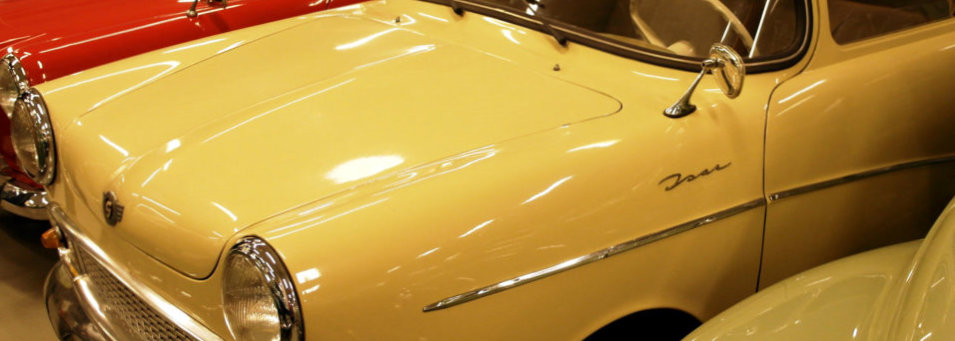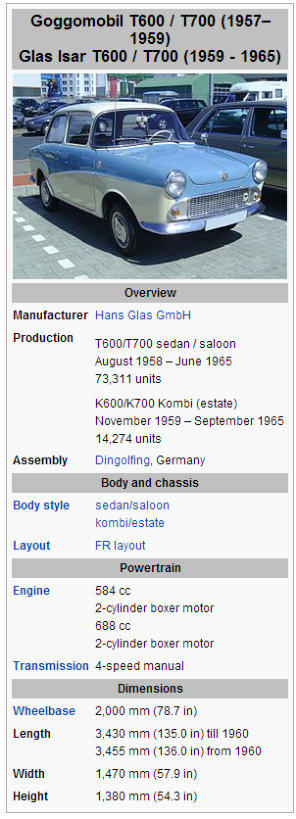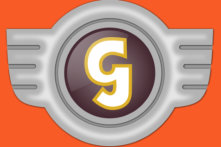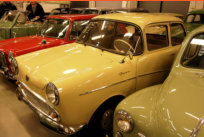




The new BIG Goggomobile

GLAS Isar T700 - 62
The Glas Isar is a small two door four seater car produced
by Hans Glas GmbH at their Dingolfing plant. The car was
first presented as the Goggomobil T600 in September
1957 at the Frankfurt Motor Show, with volume
production starting in August 1958.
Initially Glas described it simply as a “big Goggomobil”, but in Autumn 1959 it was rebranded as the Glas Isar. At the same time a kombi (estate car) version joined the range. A minor facelift occurred in August 1960 and the Isar continued in production till the end of Summer 1965.Origins
The car that appeared at the 1957 Frankfurt Motor Show was a prototype which in the event differed significantly from the car that entered production the next year, in that it used front wheel drive. In most other respects, notably regarding the two cylinder boxer engine and the overall shape of the car, only minor stylistic changes differentiated the cars that went into production in 1958 from the 1957 prototypes. The front wheel drive prototype was unstable, however, because of the way the engine was set far ahead of the front axle, and high above the front-wheel drive power train, in what was a relatively light weight car. Setting the engine further back in relation to the front wheels would have involved a level of re-engineering for which neither time nor money were available. The decision was therefore taken to switch to a rear wheel drive configuration. The late decision led to issues with the gear box, however, which could not be redesigned at this stage and was simply switched round to allow for the fact that the drive shaft pointed in the opposite direction to that previously envisaged. For the driver, this gave rise to a back to front gear change, with first and third speed gear level positions nearer the driver and second and fourth positions facing the front of the car. The late switch to rear wheel drive threatened to reduce luggage space while freeing up space under the bonnet/hood above the low profile boxer engines, and the manufacturer took the opportunity to reposition the spare wheel to a location under the bonnet/hoot in a cradle above the engine.Goggomobil T 700
By the time volume production commenced in August 1958, the T600 had been joined by the more powerful T700. In this car the 688 cc boxer motor developed a maximum power output of 22 kW (30 PS) at 4,900 rpm, which provided for a top speed of 110 km/h (69 mph) and reduced by a third the acceleration time to 100 kmh (62 mph).Name change and range expansion
In order to distance the model from the smaller and more minimalist Goggomobil, and possibly also to try and distract from reliability and structural problems that afflicted early cars, November 1959 saw a name change. The “Goggomobil T600” became the “Glas Isar T600” and the “Goggomobil T700” became the “Glas Isar T700”. In the manufacturer’s Lower Bavarian homeland the River Isar is the principal river and would have enjoyed a warm resonance with customers, though subsequently, as the company began to implement an export strategy, it was found that customers in some non-German speaking countries thought the name “Isar” sounded “funny” and cars exported to these markets were branded as the “Glas Isard” which presumably sounded less “funny” . The name change was accompanied by the appearance of a 3-door station wagon variant which was branded as the "Glas Isar K600" or "Glas Isar K700 according to engine size.Teething troubles
Early “big Goggomobils” suffered from serious reliability issues, suggesting an excessively rushed development schedule. The aluminium castings that formed the motor housings deformed at high operating temperatures leading to a doubling of the fuel consumption. Even more alarmingly, until the manufacturer inserted extra strengthening sections under the floor, the body flexed on bumpy roads so much that small cracks appeared and, in extreme cases, the panoramic windscreen popped out of its frame. Teething troubles on the early T600 and T700 models burdened the manufacturer with high warranty costs and severely damaged the reputation of Glas cars in the market place.Facelift
The only significant facelift was revealed in August 1960. The cars grew an extra 25 mm (1 inch) in length, apparently to accommodate the slightly more prominent rear lights. The option of chrome plated bumpers was added in order to comply with new construction regulations in the USA. The rear lights were still vertically mounted on the corners of the car underneath little tail fins, but they now became larger and took on a rectangular shape, simpler than hitherto. The rear bumper was reshaped to accommodate the larger lights and the handle for the boot/ trunk lid was repositioned, along with the light that illuminated the rear license plate. The rear roof was reshaped to allow for a much larger rear window which followed contemporary styling trends and expanded the view out. Buyers of the smaller engined Isar T600 saw the claimed maximum power output reduced from to 15 kW (20 PS) to, 14 kW (19 PS). Curiously the claimed maximum speed of the T600 nevertheless increased to 105 km/h (65 mph). In September 1959 the design of the carburetor had been changed and the supplier switched from Bing to Solex. In 1960, possibly reflecting the increasing minimum octane levels of available fuels, the compression ratio was raised slightly, and the reduction in claimed power also coincided with one of the two changes to the lower gear ratios implemented during the car’s life. There was no significant facelift between 1960 and 1965, but towards the end of the production run the car acquired a black synthetic leather covering on the dashboard. In the final cars the Isar’s original seats and steering wheel were replaced by those from the newer and slightly larger Glas 1004.Commercial
Between 1958 and 1965 Glas produced 73,311 Isar saloons and, between 1959 and 1965 a further 14,274 Isar kombis. 57% of the saloons and 88% of the kombis were delivered with the larger 688 cc engine. Between 1960 and 1965 the Isar was also built (badged as the Isard) at the company's plant in Argentina where it is remembered as one of the most popular cars of the 1960s.
1962
Engine 688 cc 2 cylinders Power 30 HP Top speed 112 km/h Lenght/width 3,43 m/1,47 m Weight 600 kg
Photos mainly by Matti Kreivilä. Historical facts and technical details of the vehicles provided by Wikipedia. Movies YouTube.



- Autobianchi Transformable - 1960
- Autobianchi Familiare - 1962
- Autobianchi Panoramica - 1962
- Autobianchi Cabriolet - 1963
- BMW Isetta 300 - 1956
- BMW Isetta 300 - 1959
- BMW Isetta Standard
- BMW 600 - 1959
- Bond Bug ES 700 - 1973
- Fiat Topolino - 1936
- Fiat Topolino - 1939
- Fiat Topolino - 1951
- Fiat Belvedere - 1952
- Fiat Topolino - 1954
- Fiat 600 - 1955
- Fiat 500 - 1963
- Fiat 500 - 1969
- Fiat Multipla - 1965
- Fuldamobil 4-wheel - 1958
- Fuldamobil King S7 - 1959
- GLAS Isar T700 - 1962
- Goggomobil T400 - 1959
- Goggomobil T250 - 1961
- Goggomobil T250 - 1969
- Goggomobil Coupe
- Heinkel Kabine - 1959
- Honda N600 - 1970
- Jalta Saporoshez - 1967
- Lloyd Alexander TS - 1960
- Messerschmitt KR200 - 1960
- Messerschmitt KR201
- Messerschmitt KR200 - 1963
- Messerschmitt KR200 - 1964
- NSU Prinz I - 1958
- Scootacar Mk3 - 1963
- Steyr-Puch 500 -1961
- Steyr-Puch 650 - 1964
- Trabant P 50 - 1961
- Trojan 603/198 - 1964
- Trojan 3-wheeler - 1964
- Trojan 3-wheeler - 1964
- Vespa 400 - 1959
- Victoria Spatz 250 - 1957
- ZŁndapp Janus - 1959


- About Scooters
- Apollo moped
- Cezeta 175 - 1960
- Heinkel Tourist - 1960
- Lambretta 125 - 1953
- Puch SR 150 - 1958
- Pyrkijš moped
- Suzuki Burgman 400
- Tunturi City - 1980
- Vespa 150 - 1959
- Yamaha Passola 50 - 1980
- ZŁndapp Bella w. sidecar - 1960
- ZŁndapp Bella 204 - 1960
- ZŁndapp Bella 200 Deluxe - 1963
- ZŁndapp Combinette




















